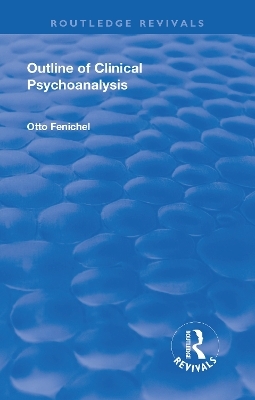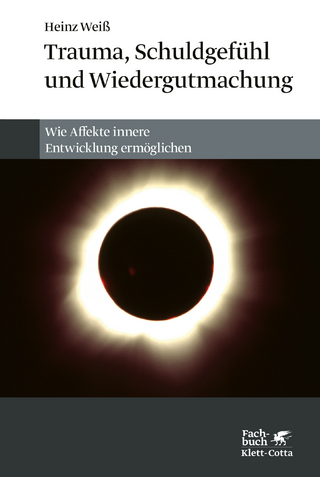
Revival: Outline of Clinical Psychoanalysis (1934)
Routledge (Verlag)
978-1-138-55376-7 (ISBN)
The wealth of clinical and theoretical data which psychoanalysis has been gathering for almost forty years as yet awaits an adequate systematization. A number of summaries and more or less complete systematic reviews of the field of psychoanalysis have been attempted and a number of them, of greater or less value, have been published with either the specialist or the general medical or or lay public in mind. Dr. Fenichel’s Outline is not one of these attempts.
It is rather a systematized and almost impersonal presentation of clinical data which psychoanalysis has collected in the course of almost forty years and Dr. Fenichel frankly sacrifices simplified clarity to systematic completeness. The clinician will find it a very useful reference book; the general medical reader or the psychologist will find it to be a plain statement of fact made without prejudice or special preference to any of the variety of currents in present day psychoanalytical thought. It is the first outline of what the psychoanalytical trends are in the field of clinical work, leaving out the controversial attitudes which are always to be found in a living scientific discipline that has not yet become dogmatized.
Otto Fenichel (2 December 1897 in Vienna – 22 January 1946 in Los Angeles) was a psychoanalyst of the so-called "second generation". Otto Fenichel started studying medicine in 1915 in Vienna. Already as a very young man, when still in school, he was attracted by the circle of psychoanalysts around Freud. During the years 1915 and 1919, he attended lectures by Freud, and as early as 1920, aged 23, he became a member of the Vienna Psychoanalytic Society. In 1922 Fenichel moved to Berlin. During his Berlin time, until 1934, he was a member of a group of Socialist and/or Marxist psychoanalysts (with Siegfried Bernfeld, Erich Fromm, Wilhelm Reich, Ernst Simmel, Frances Deri and others). After his emigration – 1934 to Oslo, 1935 to Prague, 1938 to Los Angeles – he organized the contact between the worldwide scattered Marxist psychoanalysts by means of top secret "Rundbriefe", i.e. circular letters. Those Rundbriefe, which became publicly known only in 1998, can be counted among the most important documents pertaining to the problematic history of psychoanalysis between 1934 and 1945, especially in regard to the problem of the expulsion of Wilhelm Reich from the International Psychoanalytic Association in 1934. Fenichel was a prolific writer on psychoanalysis, and published some forty articles between "Introjektion und Kastrationkomplex" (1925) and "Neurotic Acting Out" (1945). Among some of the areas he contributed to were female sexuality, the feeling of triumph, and the antecedents of the Oedipus complex. He also published an influential technical manual, Problems of Psychoanalytic Technique (1939). Three interwar papers on female sexuality, attracted Freud's own attention: he wrote of the first that "Fenichel (1930) rightly emphasizes the difficulty of recognizing in the material produced in analysis what parts of it represent the unchanged content of the pre-Oedipus phase and what parts have been distorted by regression"." His 1936 article on the symbolic equation of Girl and Phallus subsequently became a launch pad for Jacques Lacan. In his 1939 article "Trophy and Triumph", Fenichel pointed out that the feeling of triumph "results from the removal of anxiety and inhibition by the winning of a trophy", but added that as "the trophy is a super-ego derivative since it is a symbol of parental authority[...]it threatens the ego in the same way that the super-ego threatens the ego" Building on his own work, and the contributions of his peers and predecessors, Fenichel produced his encyclopedic textbook of 1945: "For countless students and professionals Fenichel is synonymous with his Psychoanalytic Theory of Neurosis; and this text is regarded as synonymous with reliable and comprehensive psychoanalytic knowledge." Nevertheless, the work was not uncontroversial, challenging among others the findings of Melanie Klein, the neo-Freudians and much of the work of Franz Alexander, as well as displaying Fenichel's continuing Marxist affiliation. Harold Bloom called Fenichel the "grim encyclopaedist of the Freudian psychodynamics"; but it was precisely the encyclopedic aspect of his work which aroused the criticism of Lacan. Comparing Fenichel's work to "an enumeration of the 'main sewer' type", he argued for a distinction between a catalogue of past interpretations, and the actual job of finding the mutative interpretation within the actual session. He also criticised Fenichel's use of organic stages of development in his writing; while others saw Fenichel as oversimplifying his accounts of neurosis by categorical taxonomies. Although Fenichel himself had warned from the start of his book that he was only offering illustrative examples, not case histories, he may have unwittingly contributed to the vice of attempting to mastermind, not follow and learn from, the analytic process. Bertram D. Lewin (Bertram David, 1896-1971) was an American psychoanalyst who was both an acute clinician and a contributor to theory, particularly to the study of elation, and of the dream screen. Lewin had a training analysis with Franz Alexander in Berlin in the twenties, before publishing his first analytic article in 1930. This was followed by ten more over the next decade, on subjects ranging from diabetes and claustrophobia to the body as phallus. The main focus of his interest, however, was in manic states, which he saw as characterised by fleeting identifications with a multiple of outside figures. After the war, he published the fruits of his investigations in The Psychoanalysis of Elation (1951). There he stressed the role of denial in mania – denial particularly of feelings of separation and loss. He also explored the paradox in elation's dark counterpart, depression, whereby the melancholic in seeking to punish the effigy of their loved one in fact punishes themselves having incorporated this effigy. By that point he had also published his seminal article (1946) on the dream screen – the backcloth formed from primitive memories of the breast onto which the dream is projected. The concept would be fruitfully followed up both within analysis, and in the context of film theory. Gregory Zilboorg (Russian: Григорий Зильбург, Ukrainian: Григорій Зільбург) (December 25, 1890 – September 17, 1959) was a psychoanalyst and historian of psychiatry who is remembered for situating psychiatry within a broad sociological and humanistic context in his many writings and lectures. Zilboorg was born in Kiev, Ukraine on December 25, 1890 and studied medicine in St. Petersburg, where he worked under Vladimir Bekhterev. In 1917 he served in the Ministry of Labor for two presidents (Aleksandr Kerenskii and Georgii L'vov). Zilboorg emigrated to the United States in 1919 and for a time supported himself by translating literature from Russian to English while studying medicine at Columbia University. Among the works he translated is Evgenii Zamiatin's We. After graduating in 1926, he worked at the Bloomingdale Hospital and eventually established a psychoanalytic practice in New York City, having first been analysed in Europe by Franz Alexander. From the 1930s onward, Zilboorg produced several volumes of lasting importance on the history of psychiatry. The Medical Man and the Witch During the Renaissance began as the Noguchi lectures at Johns Hopkins University in 1935. This volume was followed by A History of Medical Psychology in 1941 and Sigmund Freud in 1951. He also produced a series of clinical articles, on subjects from the schizoid personality to postpartum depression - he considered the latter as rooted in ambivalence over motherhood and latent sadism - and explored the effects of unresolved conflicts and countertransference affects of the analyst in the analytic situation. Zilboorg's patients included George Gershwin, Lillian Hellman, Ralph Ingersoll, Edward M.M. Warburg, Marshall Field, Kay Swift and James Warburg. The musical Lady in the Dark is reportedly based on Moss Hart's experience undergoing analysis with Zilboorg. Zilboorg married Ray Liebow in 1919 and they had two children (Nancy and Gregory, Jr.). He married Margaret Stone in 1946 and they had three children (Caroline, John and Matthew). Zilboorg's papers at the Beinecke Rare Book and Manuscript Library, Yale University, contain manuscripts of several of his publications as well as his personal correspondence with Margaret Stone Zilboorg.
I. Hysteria II. Anxiety Hysteria III. Hysteriform Conditions IV. Hysteriform Conditions (Continued) V. Compulsion Neurosis VI. Pregenital Conversion Neurosis VII. The Sexual Perversion VIII. Neuroses related to Perversion IX. The Schizophrenias X. The Manic-Depressive Group XI. Character Disorders
| Erscheinungsdatum | 15.01.2018 |
|---|---|
| Reihe/Serie | Routledge Revivals |
| Übersetzer | Bertram D Lewin, Gregory Zilboorg |
| Verlagsort | London |
| Sprache | englisch |
| Maße | 138 x 216 mm |
| Gewicht | 453 g |
| Themenwelt | Geisteswissenschaften ► Psychologie ► Allgemeine Psychologie |
| ISBN-10 | 1-138-55376-X / 113855376X |
| ISBN-13 | 978-1-138-55376-7 / 9781138553767 |
| Zustand | Neuware |
| Haben Sie eine Frage zum Produkt? |
aus dem Bereich


